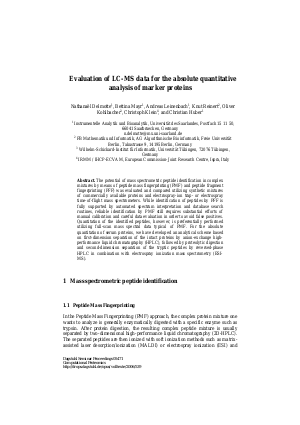Evaluation of LC-MS data for the absolute quantitative analysis of marker proteins
Authors Nathanaël Delmotte, Bettina Mayr, Andreas Leinenbach, Knut Reinert, Oliver Kohlbacher, Christoph Klein, Christian G. Huber
-
Part of:
Volume:
Dagstuhl Seminar Proceedings, Volume 5471
Part of: Series: Dagstuhl Seminar Proceedings (DagSemProc) - License:
 Creative Commons Attribution 4.0 International license
Creative Commons Attribution 4.0 International license
- Publication Date: 2006-05-03
File

PDF
DagSemProc.05471.6.pdf
- Filesize: 49 kB
- 5 pages
Document Identifiers
Subject Classification
Keywords
- RP-HPLC
- monolith
- Mascot
- Myoglobin
- Absolute quantitation
- Serum
Metrics
- Access Statistics
-
Total Accesses (updated on a weekly basis)
0Document
0Metadata
Abstract
The serum complexity makes the absolute quantitative analysis of medium to low-abundant proteins very challenging. Tens of thousands proteins are present in human serum and dispersed over an extremely wide dynamic range. The reliable identification and quantitation of proteins, which are potential biomarkers of disease, in serum or plasma as matrix still represents one of the most difficult analytical challenges. The difficulties arise from the presence of a few, but highly abundant proteins in serum and from the non-availability of isotope-labeled proteins, which serve to calibrate the method and to account for losses during sample preparation. For the absolute quantitation of serum proteins, we have developed an analytical scheme based on first-dimension separation of the intact proteins by anion-exchange high-performance liquid chromatography (HPLC), followed by proteolytic digestion and second-dimension separation of the tryptic peptides by reversed-phase HPLC in combination with electrospray ionization mass spectrometry (ESI-MS). The potential of mass spectrometric peptide identification in complex mixtures by means of peptide mass fingerprinting (PMF) and peptide fragment fingerprinting (PFF) was evaluated and compared utilizing synthetic mixtures of commercially available proteins and electrospray-ion trap- or electrospray time-of-flight mass spectrometers. While identification of peptides by PFF is fully supported by automated spectrum interpretation and database search routines, reliable identification by PMF still requires substantial efforts of manual calibration and careful data evaluation in order to avoid false positives. Quantitation of the identified peptides, however, is preferentially performed utilizing full-scan mass spectral data typical of PMF. Algorithmic solutions for PMF that incorporate both recalibration and automated feature finding on the basis of peak elution profiles and isotopic patterns are therefore highly desirable in order to speed up the process of data evaluation and calculation of quantitative results. Calibration for quantitative analysis of serum proteins was performed upon addition of known amounts of authentic protein to the serum sample. This was essential for the analysis of human serum samples, for which isotope-labeled protein standards are usually not available. We present the application of multidimensional HPLC-ESI-MS to the absolute quantitative analysis of myoglobin in human serum, a very sensitive biomarker for myocardial infarction. It was possible to determine myoglobin concentrations in human serum down to 100-500 ng/mL. Calibration graphs were linear over at least one order of magnitude and the relative standard deviation of the method ranged from 7-15%.
Cite As Get BibTex
Nathanaël Delmotte, Bettina Mayr, Andreas Leinenbach, Knut Reinert, Oliver Kohlbacher, Christoph Klein, and Christian G. Huber. Evaluation of LC-MS data for the absolute quantitative analysis of marker proteins. In Computational Proteomics. Dagstuhl Seminar Proceedings, Volume 5471, pp. 1-5, Schloss Dagstuhl – Leibniz-Zentrum für Informatik (2006)
https://doi.org/10.4230/DagSemProc.05471.6
BibTex
@InProceedings{delmotte_et_al:DagSemProc.05471.6,
author = {Delmotte, Nathana\"{e}l and Mayr, Bettina and Leinenbach, Andreas and Reinert, Knut and Kohlbacher, Oliver and Klein, Christoph and Huber, Christian G.},
title = {{Evaluation of LC-MS data for the absolute quantitative analysis of marker proteins}},
booktitle = {Computational Proteomics},
pages = {1--5},
series = {Dagstuhl Seminar Proceedings (DagSemProc)},
ISSN = {1862-4405},
year = {2006},
volume = {5471},
editor = {Christian G. Huber and Oliver Kohlbacher and Knut Reinert},
publisher = {Schloss Dagstuhl -- Leibniz-Zentrum f{\"u}r Informatik},
address = {Dagstuhl, Germany},
URL = {https://drops.dagstuhl.de/entities/document/10.4230/DagSemProc.05471.6},
URN = {urn:nbn:de:0030-drops-5397},
doi = {10.4230/DagSemProc.05471.6},
annote = {Keywords: RP-HPLC, monolith, Mascot, Myoglobin, Absolute quantitation, Serum}
}
